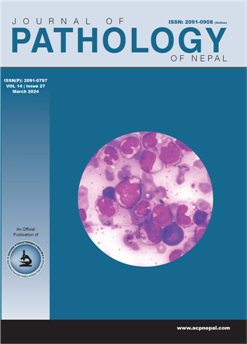Spectrum of renal diseases in the pediatric population of Nepal
DOI:
https://doi.org/10.3126/jpn.v14i1.65917Keywords:
Chronic kidney disease, Glomerular diseases, Immunofluorescence, Light microscopy, Pediatric renal disease, Post-infectious glomerulonephritis, Rapidly progressive glomerulonephritisAbstract
Background: The spectrum of renal diseases varies with different ethnic populations, geographical locations and environmental factors. In children, many signs of kidney disease are either hidden or mimic other systemic diseases. There is a need of identifying renal disorders at an early stage to retard the rapid progression. This study aims to identify the different histopathological spectrum of glomerular diseases in pediatric renal biopsies.
Materials and Methods: This was a cross-sectional prospective study undertaken at the Pathology Department at Pratham Pathology Laboratory, Lazimpat for 17 months duration (May 1ST - December 31ST 2023). The final diagnosis was made by a pathologist after correlating the histopathological findings with immunofluorescence and other clinical and laboratory findings.
Results: A total of 97 pediatric patients’ renal biopsy specimens were evaluated. Patients’ age ranged from 0-16 years. The majority of patients were in the age group of 11-16 years (62.8%). The study showed slight female predominance with male to female ratio of 0.8:1. The most common glomerular disease was Lupus Nephritis with a frequency of 19 (19.6%). The most common cause for Rapid progressive Glomerulonephritis in the pediatric population was Post Infectious Glomerulonephritis with a frequency of 5 (50%).
Conclusions: The most commonly diagnosed glomerular disease in pediatric renal biopsies was Lupus Nephritis. The leading cause of Rapid Progressive Glomerulonephritis was Post Infectious Glomerulonephritis and Lupus was one of the leading causes of chronic kidney disease.
Downloads
Downloads
Published
How to Cite
Issue
Section
License
Copyright (c) 2024 The Author(s)

This work is licensed under a Creative Commons Attribution 4.0 International License.
This license enables reusers to distribute, remix, adapt, and build upon the material in any medium or format, so long as attribution is given to the creator. The license allows for commercial use.




